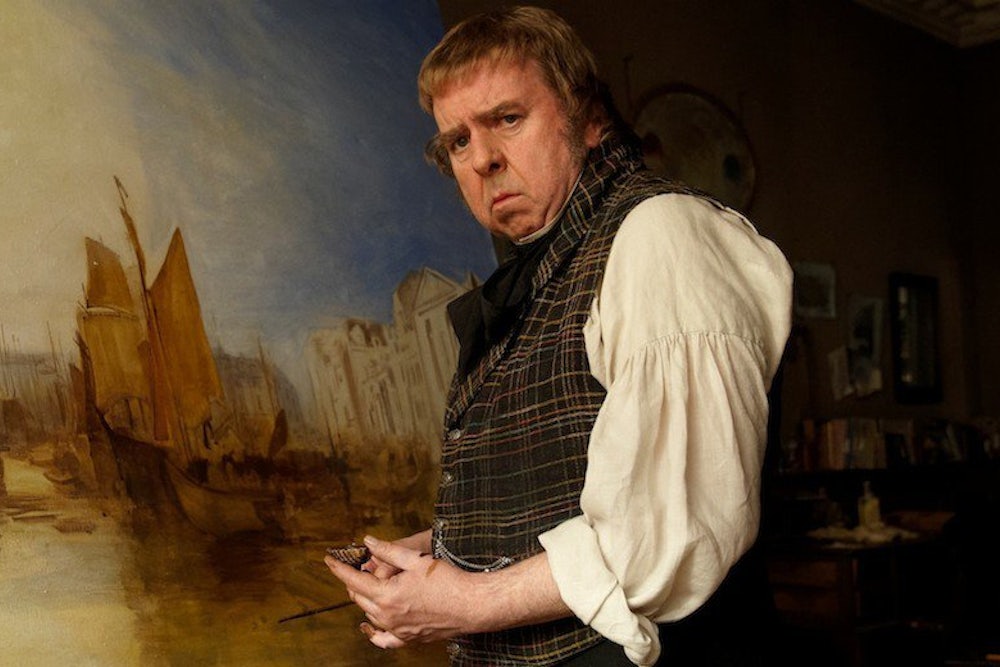Mike Leigh's Mr. Turner is easy on the eyes, but hard to digest. Its costumes and cinematography have received Oscar nominations, but its politics are a peculiarly and perversely British kind of anachronism: Set in the 1830s and ’40s, the movie links J.M.W. Turner's groundbreaking late style to the dawn of a class-ridden industrial society. But the conception of class presented in Mr. Turner—the lazy upper class, the moralizing middle class, and the industrial working class—is actually a creation of the late nineteenth century. Projecting it backwards onto Turner reveals more about Mike Leigh's politics than about Turner, his art, or the society in which he lived.
Mike Leigh, a seven-time Oscar nominee, is a lifelong combatant in Britain's war without end—the class war. His early films captured the agonies of the Thatcher years, when the traditional working class collapsed. In High Hopes (1988), a working-class man loses his family to the sentimental conservatism and social climbing of its women. In Life is Sweet (1990), a working-class father chases the Thatcherite dream of owning his own business, and nearly wrecks his family.
Leigh's distant, dispassionate style was always too stylized to pass as social realism. Still, as his society changed, he drifted from reality. In Tony Blair's Britain, Leigh's politics became period nostalgia: Topsy-Turvy (1999), on the light opera team Gilbert and Sullivan, was a love letter to Victorian show business; Vera Drake (2004), about an illegal abortionist in the 1950s, was a sentimental fantasy about the lost world of Leigh's childhood.
With Mr. Turner, Leigh drifts further from historical reality. Turner, played by Timothy Spall, is portrayed as a working-class insurgent against the manners and mediocrity of the Victorian middle class. But Turner was not much of a Victorian. He died in 1851, when Victoria was in the fourteenth year of her 64-year reign. 1851 was also the year that the English became the first people to have a majority of its population living in cities; the year of the Great Exhibition, the first global trade fair; the year that Karl Marx, visiting the Exhibition, theorized what we now call "globalization." In other words, Turner died just as the modern class system and its economic arrangements were born.
Moreover, Turner came from London's "middling sort," the precursor of the future middle class. His mother's family lived on the rent of several properties. The men of his father's family were respectable artisans and small traders. He became a rich man through his acute reading of the market and the game of patronage. He settled in a fashionable neighborhood and was his own dealer, with a private gallery in his house. Turner was a harbinger of the modern middle class—and not, as Mike Leigh suggests, the modern proletariat.
Mr. Turner begins in the 1830s when Turner, after 40 years of critical and popular acclaim for his landscape and maritime scenes, parted company with both the critics and the public. Turner had always been a whirler and smudger, but now he seemed to dispense with form and representation. His oils became watery and ethereal, like light itself. Objects dissolve in the wash, or float in a glowing mist, or disappear into the vortex of Nature. The public recoiled—in the film, Queen Victoria calls Turner's Sunrise with Sea Monsters (1845) a "dirty yellow mess”—and the critics dropped him. Even John Ruskin, one of Turner's last defenders, wondered if Turner was suffering from "incurable mental disease." In Leigh's view, this late style is an act of class war. When the Academy rejects the work of Turner's friend Benjamin Robert Haydon, in part due to his lack of business sense, Turner is driven to an artistic breakthrough, stabbing and spitting at his canvas in fury.
For years, Timothy Spall has been Mike Leigh's muse when it comes to working-class masculinity. Spall has a face made for British film. He wears his teeth at a rakish angle, and is heroically unfit. His vibrant jowls and moist mouth hint at unplumbed emotion and thwarted potential; every quaver suggests the imminent collapse of his reserve. Here, he articulates the pain of the inarticulate workers, mostly in a repertoire of porcine grunts. His performance is hypnotically hammy, but there is no evidence that Turner's late style was a political act, a spitting in the face of his society. Quite the opposite: Turner, an old-fashioned patriot, identified so deeply with his people that he became the first modern artist to bequeath his work to the nation. Today, most of Turner's major works can be seen for free at London's Tate Gallery and National Gallery.
In an interview with the Guardian, Leigh called the late Turner a "radical, revolutionary painter,” a statement that confuses art with politics. Today, Turner's late works are praised as anticipating Impressionism, but this view is in itself anachronistic. Monet loved Turner, but Turner's favorite artist was Claude Lorrain, a Baroque painter of placid harbors and Classical myths. It’s only today that we think of him as a revolutionary. Art history is written by the buyers and with the privilege of hindsight.
The British, among whom I number by birth, if not residence, call the retailing of their historical clichés "selling England by the pound." Like the tap-dancing chimney sweeps in Mary Poppins and the aristocratic paradise of "Downton Abbey," Mr. Turner offers an ahistorical fantasy. The Victorian class system is long gone, yet its enemies cling to its image no less fiercely than its admirers—for the modern British, like Turner and his contemporaries, live in a time of turmoil and transition. In the confusion of the present, the lost certainties of class are a comfort. Familiarity may breed contempt, but at least it is familiar.
For more Oscar coverage, click here.
